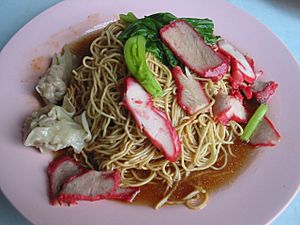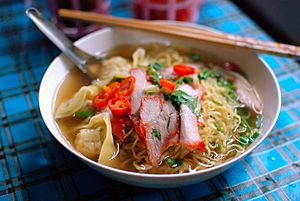Wonton noodles facts for kids

A bowl of wonton noodle soup
|
|
| Type | Noodles |
|---|---|
| Course | Main course |
| Place of origin | China |
| Region or state | Guangdong, Hong Kong, Indonesia, Malaysia, Singapore, Philippines and Thailand |
| Serving temperature | Hot |
| Main ingredients | flour, egg, pork, shrimp |
| Wonton noodles | |||||||||||||
|---|---|---|---|---|---|---|---|---|---|---|---|---|---|
| Traditional Chinese | 雲吞麵 | ||||||||||||
| Simplified Chinese | 云吞面 | ||||||||||||
| Literal meaning | Wonton noodles | ||||||||||||
|
|||||||||||||
Wonton noodles (Chinese: 雲吞麵; Cantonese Yale: wàhn tān mihn, also called wanton mee or wanton mein) is a noodle dish of Cantonese origin. Wonton noodles were given their name, húntún (餛飩), in the Tang Dynasty (618-907 CE). The dish is popular in Southern China, Hong Kong, Indonesia, Malaysia, Singapore and Thailand. The dish usually consists of egg noodles served in a hot broth, garnished with leafy vegetables and wonton dumplings. The types of leafy vegetables used are usually gai-lan, also known as Chinese broccoli or Chinese kale. Another type of dumpling known as shui jiao (水餃) is sometimes served in place of wonton. Shrimp wonton are mostly known as Hong Kong dumplings. The wontons contain prawns, chicken or pork, and spring onions, with some chefs adding mushroom and black fungus. In Indonesia especially in North Sumatra, West Kalimantan and South Sulawesi, wonton noodles are called mie pangsit.
Guangzhou and Hong Kong
In Guangzhou and Hong Kong, wonton noodles are usually served in steaming hot soup with shrimp wontons and garnished with leafy vegetables. There are plenty of variations of this popular Cantonese dish, with different toppings and garnishes. For example, the soup and wontons being in separate bowls, the noodles being served relatively dry, served with toppings and garnishes, dressed with sauce, or dipping the noodles in the soup to eat it.
There are four distinct features: First, the wontons are predominantly prawn, with small amounts of minced pork, or no pork at all. The traditional filling for wontons consists of 70% shrimp and 30% pork. Second, the noodles are fresh, smooth thin noodles that are al dente, free from the taste and odor which is characteristic in many egg noodles when they are cooked. Third, the bouillon is light brown (prepared from dried flounder) and is usually steaming hot. Lastly, garlic chives are used as a garnish. The first two give the dish a wet but crunchy or crispy mouth feel. The last two give the dish a unique bouquet.
In order to ensure that the noodles are perfectly al dente, and free from raw taste, the cooking process and sequence must be meticulously adhered to. The wonton is cooked first and then placed in the bowl. The noodles are blanched for only 10 seconds, after which they are rinsed under cold water and placed in the serving bowl. Piping hot bouillon is then scooped into the bowl, on top of the wonton noodles. The bouillon must be tasty, yet not so strong as to overpower the delicate taste of the wonton and the noodles which it is meant to accompany.
When served, the spoon must be placed at the bottom, with the wontons above the spoon and the noodles on top. Because the noodles soak in the soup for too long then it will be over-cooked, this is strictly adhered to by the best wonton noodle establishments.
Although the "wonton noodle" is synonymous with wonton and noodles served in piping hot bouillon, the dish may also be served "damp", as in lo mein (撈麵), where the wonton are placed on a large bed of noodles.
Malaysia

Malaysia offers different versions of the dish, with different states having different versions of the dish and there are versions from Johor, Pahang, Perak, Penang, Sarawak, and Selangor. The Malaysian version differs from the original in having slices of char siu added to the dish, as well as the possibility of the soup and wontons being in separate bowls, the noodles being served relatively dry, dressed with oyster sauce and garnished with chopped spring onions. Some stalls include deep-fried wontons in the dry versions as well.
Often served wet, the Hong Kong version can be found at Cantonese noodle joints with it being dry or soup. In Malacca, wontons are placed together with the noodles and wonton soup can be ordered separately. The Malacca version is also usually spicier than the other Malaysian versions due to the use of a special unsweetened chili sauce.
Vegetarian wonton mee is also served in Malaysia in vegetarian restaurants. Instead of using pork to make char siu, wheat gluten is used.
Philippines
There are three distinct types of wonton noodle dishes found in Philippines. One is mami, which is a noodle soup that has egg noodles, wontons, and various vegetables in a hot broth. The name mami is derived from a Chinese phrase that means “pork noodles". Another type is pancit molo, which is similar to mami, but the noodles used are the wonton wrappers themselves. The third type of wonton noodles is stir-fry egg noodles sold by hawkers and in small "stand-up" type stalls. Here, the noodles are stir-fried with mung bean sprouts and vegetables, flavored with a range of sauces, and finally topped with wontons.
Singapore
Singapore wonton noodles includes noodles, leafy vegetables (preferably cai-xin), barbecued pork (char siu) and bite-sized dumplings or wonton. It is either served dry or in soup form with the former being more popular. If served dry, the wontons will be served in a separate bowl of soup. Shui jiao or prawn dumplings are served at some stalls and the original Hong Kong version is available at Cantonese restaurants and noodle joints. Fried wontons (wontons deep-fried in oil) are sometimes served instead of those boiled in the soup. The Singaporean and Malaysian versions of the wonton noodle are similar to each other, though the Singapore version uses significantly less soy sauce and is often served with hot, spicy chilli ketchup.
Thailand

Wonton noodles (Thai: บะหมี่เกี๊ยว; bami kiao) are also very popular in Thailand, where, as in Malaysia and Singapore, the dish is often ordered together with barbecued pork which is then called bami mu daeng kiao (Thai: บะหมี่หมูแดงเกี๊ยว; mu daeng meaning "red pork"). As is customary with many noodle soups of Chinese origin in Thailand, chillies preserved in vinegar, dried chilli flakes, sugar, and fish sauce are added to taste. The dish is mostly eaten in soup form but it can also be served dry with the broth on the side.
Vietnam
Súp mì or mì for short is a Chinese-Vietnamese noodle soup, introduced to Vietnam by Chinese immigrants. Mì hoành thánh is the Vietnamese version of wonton noodle soup. Noodles can be served with the soup or soup separately. Common ingredients are yellow wheat (egg) noodles with pork-based broth, ground pork, chives, and various meats and toppings.
See also
 In Spanish: Wanton mee para niños
In Spanish: Wanton mee para niños


